Thermodynamic and Economic Analyses of a New Waste-to-Energy System Incorporated with a Biomass-Fired Power Plant
Abstract
1. Introduction
2. Reference Plants and Concept Proposal
2.1. Reference WtE Plant
2.2. Reference Biomass-Fired Power Plant
2.3. Proposed Hybrid System
3. System Simulation
4. Thermodynamic Analysis
4.1. Basic Hypotheses
- (a)
- The feedstock flow rates of the biomass power plant and the WtE plant are fixed.
- (b)
- The exhaust gas temperatures and efficiencies of the WtE boiler and the biomass-fired boiler remain unchanged.
- (c)
- The biomass-to-electricity efficiency and power output of the biomass power plant are invariable.
- (d)
- The temperature and pressure of the dead state are 288.15 K and 101.325 kPa.
- (e)
- The surroundings’ effects are neglected.
4.2. Energy Analysis
4.3. Exergy Analysis
5. Economic Analysis
6. Sensitivity Analysis
7. Conclusions
Author Contributions
Funding
Conflicts of Interest
References
- Ning, C.; You, F. Data-driven Wasserstein distributionally robust optimization for biomass with agricultural waste-to-energy network design under uncertainty. Appl. Energy 2019, 255, 113857. [Google Scholar] [CrossRef]
- Martínez-Guido, S.I.; Ríos-Badrán, I.M.; Gutiérrez-Antonio, C.; Ponce-Ortega, J.M. Strategic planning for the use of waste biomass pellets in Mexican power plants. Renew. Energy 2019, 130, 622–632. [Google Scholar] [CrossRef]
- Bermúdez, C.A.; Porteiro, J.; Varela, L.G.; Chapela, S.; Patiño, D. Three-dimensional CFD simulation of a large-scale grate-fired biomass furnace. Fuel Process. Technol. 2020, 198, 106219. [Google Scholar] [CrossRef]
- Situmorang, Y.A.; Zhao, Z.; Yoshida, A.; Abudula, A.; Guan, G. Small-scale biomass gasification systems for power generation (<200 kW class): A review. Renew. Sustain. Energy Rev. 2020, 117, 109486. [Google Scholar]
- Osman, A.I.; Abdelkader, A.; Farrell, C.; Rooney, D.; Morgan, K. Reusing, recycling and up-cycling of biomass: A review of practical and kinetic modelling approaches. Fuel Process. Technol. 2019, 192, 179–202. [Google Scholar] [CrossRef]
- Nunes, L.J.R.; Causer, T.P.; Ciolkosz, D. Biomass for energy: A review on supply chain management models. Renew. Sustain. Energy Rev. 2020, 120, 109658. [Google Scholar] [CrossRef]
- Zhu, Y.; Liang, J.; Yang, Q.; Zhou, H.; Peng, K. Water use of a biomass direct-combustion power generation system in China: A combination of life cycle assessment and water footprint analysis. Renew. Sustain. Energy Rev. 2019, 115, 109396. [Google Scholar] [CrossRef]
- Liu, D.; Liu, M.; Xiao, B.; Guo, X.; Niu, D.; Qin, G.; Jia, H. Exploring biomass power generation’s development under encouraged policies in China. J. Clean. Prod. 2020, 258, 120786. [Google Scholar] [CrossRef]
- Yuan, J.; Luo, X.; Ding, X.; Liu, C.; Li, C. Biomass power generation fuel procurement and storage modes evaluation: A case study in Jilin. Renew. Sustain. Energy Rev. 2019, 111, 75–86. [Google Scholar] [CrossRef]
- Mandø, M. Direct combustion of biomass. In Biomass Combustion Science, Technology and Engineering; Rosendahl, L., Ed.; Woodhead Publishing, 2013; Available online: https://www.sciencedirect.com/science/article/pii/B9780857091314500042 (accessed on 21 August 2020).
- Vamvuka, D.; Loukakou, E.; Sfakiotakis, S.; Petrakis, E. The impact of a combined pre-treatment on the combustion performance of various biomass wastes and their blends with lignite. Acta 2020, 688, 178599. [Google Scholar] [CrossRef]
- Chen, G.; Wang, X.; Li, J.; Yan, B.; Wang, Y.; Wu, X.; Velichkova, R.; Cheng, Z.; Ma, W. Environmental, energy, and economic analysis of integrated treatment of municipal solid waste and sewage sludge: A case study in China. Sci. Total Environ. 2019, 647, 1433–1443. [Google Scholar] [CrossRef] [PubMed]
- Guo, Y.; Glad, T.; Zhong, Z.; He, R.; Tian, J.; Chen, L. Environmental life-cycle assessment of municipal solid waste incineration stocks in Chinese industrial parks. Resour. Conserv. Recycl. 2018, 139, 387–395. [Google Scholar] [CrossRef]
- Singh, K.; Hachem-Vermette, C. Influence of mixed-use neighborhood developments on the performance of waste-to-energy CHP plant. Energy 2019, 189, 116172. [Google Scholar] [CrossRef]
- Lombardi, L.; Carnevale, E.; Corti, A. A review of technologies and performances of thermal treatment systems for energy recovery from waste. Waste Manag. 2015, 37, 26–44. [Google Scholar] [CrossRef]
- Zhang, H.; Yu, S.; Shao, L.; He, P. Estimating source strengths of HCl and SO2 emissions in the flue gas from waste incineration. J. Environ. Sci.-China 2019, 75, 370–377. [Google Scholar] [CrossRef]
- Xu, H.; Lin, W.Y.; Dal Magro, F.; Li, T.; Py, X.; Romagnoli, A. Towards higher energy efficiency in future waste-to-energy plants with novel latent heat storage-based thermal buffer system. Renew. Sustain. Energy Rev. 2019, 112, 324–337. [Google Scholar] [CrossRef]
- Bogale, W.; Viganò, F. A Preliminary Comparative Performance Evaluation of Highly Efficient Waste-to-Energy Plants. Energy Procedia 2014, 45, 1315–1324. [Google Scholar] [CrossRef]
- Martin, J.J.E.; Koralewska, R.; Wohlleben, A. Advanced solutions in combustion-based WtE technologies. Waste Manag. 2015, 37, 147–156. [Google Scholar] [CrossRef]
- Liuzzo, G.; Verdone, N.; Bravi, M. The benefits of flue gas recirculation in waste incineration. Waste Manag. 2007, 27, 106–116. [Google Scholar] [CrossRef]
- Strobel, R.; Waldner, M.H.; Gablinger, H. Highly efficient combustion with low excess air in a modern energy-from-waste (EfW) plant. Waste Manag. 2018, 73, 301–306. [Google Scholar] [CrossRef]
- Main, A.; Maghon, T. Concepts and experiences for higher plant efficiency with modern advanced boiler and incineration technology. In Proceedings of the 18th Annual North American Waste-to-Energy Conference, Orlando, FL, USA, 11–13 May 2010. [Google Scholar]
- Hulgaard, T.; MSc, I.S. Integrating waste-to-energy in Copenhagen, Denmark. Proc. Inst. Civ. Eng.-Civ. Eng. 2018, 171, 3–10. [Google Scholar] [CrossRef]
- Behzadi, A.; Gholamian, E.; Houshfar, E.; Habibollahzade, A. Multi-objective optimization and exergoeconomic analysis of waste heat recovery from Tehran’s waste-to-energy plant integrated with an ORC unit. Energy 2018, 160, 1055–1068. [Google Scholar] [CrossRef]
- Consonni, S.; Silva, P. Off-design performance of integrated waste-to-energy, combined cycle plants. Appl. Eng. 2007, 27, 712–721. [Google Scholar] [CrossRef]
- Poma, C.; Verda, V.; Consonni, S. Design and performance evaluation of a waste-to-energy plant integrated with a combined cycle. Energy 2010, 35, 786–793. [Google Scholar] [CrossRef]
- Mendecka, B.; Lombardi, L.; Gładysz, P.; Stanek, W. Exergo-Ecological Assessment of Waste to Energy Plants Supported by Solar Energy. Energies 2018, 11, 773. [Google Scholar] [CrossRef]
- Chen, H.; Zhang, M.; Xue, K.; Xu, G.; Yang, Y.; Wang, Z.; Liu, W.; Liu, T. An innovative waste-to-energy system integrated with a coal-fired power plant. Energy 2020, 194, 116893. [Google Scholar] [CrossRef]
- STEAG Energy Services, EBSILON Professional Documentation; 2020; Available online: https://www.ebsilon.com/en/ (accessed on 21 August 2020).
- Liu, Z.; Liu, B.; Guo, J.; Xin, X.; Yang, X. Conventional and advanced exergy analysis of a novel transcritical compressed carbon dioxide energy storage system. Energy Convers. Manag. 2019, 198, 111807. [Google Scholar] [CrossRef]
- Mahabadipour, H.; Srinivasan, K.K.; Krishnan, S.R. An exergy analysis methodology for internal combustion engines using a multi-zone simulation of dual fuel low temperature combustion. Appl. Energy 2019, 256, 113952. [Google Scholar] [CrossRef]
- Zhou, J.; Ling, P.; Su, S.; Xu, J.; Xu, K.; Wang, Y.; Hu, S.; Zhu, M.; Xiang, J. Exergy analysis of a 1000 MW single reheat advanced supercritical carbon dioxide coal-fired partial flow power plant. Fuel 2019, 255, 115777. [Google Scholar] [CrossRef]
- Zhao, X.; Jiang, G.; Li, A.; Wang, L. Economic analysis of waste-to-energy industry in China. Waste Manag. 2016, 48, 604–618. [Google Scholar] [CrossRef]
- Xiangba, Z. Cost analysis of waste incineration-power generation projects. Environ. Sanit. Eng. 2014, 22, 57–60. (In Chinese) [Google Scholar]
- National Development and Reform-Commission. The Notice on Improving Price Policies of WtE Plants; Beijing, China, 2012. (In Chinese). Available online: http://www.nea.gov.cn/2014-09/29/c_133682178.htm (accessed on 21 August 2020).
- Ye, C. Research on the Key Issue of Coal Partial Gasification Technology; Zhejiang University: Hangzhou, China, 2018. (In Chinese) [Google Scholar]
- Han, Y. Collaborative Optimization of Energy Utilization and Pollutant Emission Reduction in Cold End of Boiler in Coal-Fired Power Generation System; North China Electric Power University: Beijing, China, 2018. (In Chinese) [Google Scholar]
- Electric Power Planning and Engineering-Institute. Quota Design Reference Cost Indicators for Thermal Power Projects (2017 Level); China Electric Power Press: Beijing, China, 2018. (In Chinese) [Google Scholar]
- Ogorure, O.J.; Oko, C.O.C.; Diemuodeke, E.O.; Owebor, K. Energy, exergy, environmental and economic analysis of an agricultural waste-to-energy integrated multigeneration thermal power plant. Energy Convers. Manag. 2018, 171, 222–240. [Google Scholar] [CrossRef]
- Lian, Z.T.; Chua, K.J.; Chou, S.K. A thermoeconomic analysis of biomass energy for trigeneration. Appl. Energy 2010, 87, 84–95. [Google Scholar] [CrossRef]
- Zhang, C.; Liu, C.; Wang, S.; Xu, X.; Li, Q. Thermo-economic comparison of subcritical organic Rankine cycle based on different heat exchanger configurations. Energy 2017, 123, 728–741. [Google Scholar] [CrossRef]
- Owebor, K.; Oko, C.O.C.; Diemuodeke, E.O.; Ogorure, O.J. Thermo-environmental and economic analysis of an integrated municipal waste-to-energy solid oxide fuel cell, gas-, steam-, organic fluid- and absorption refrigeration cycle thermal power plants. Appl. Energy 2019, 239, 1385–1401. [Google Scholar] [CrossRef]
- Liu, M.; Zhang, X.; Ma, Y.; Yan, J. Thermo-economic analyses on a new conceptual system of waste heat recovery integrated with an S-CO2 cycle for coal-fired power plants. Energy Convers. Manag. 2018, 161, 243–253. [Google Scholar] [CrossRef]




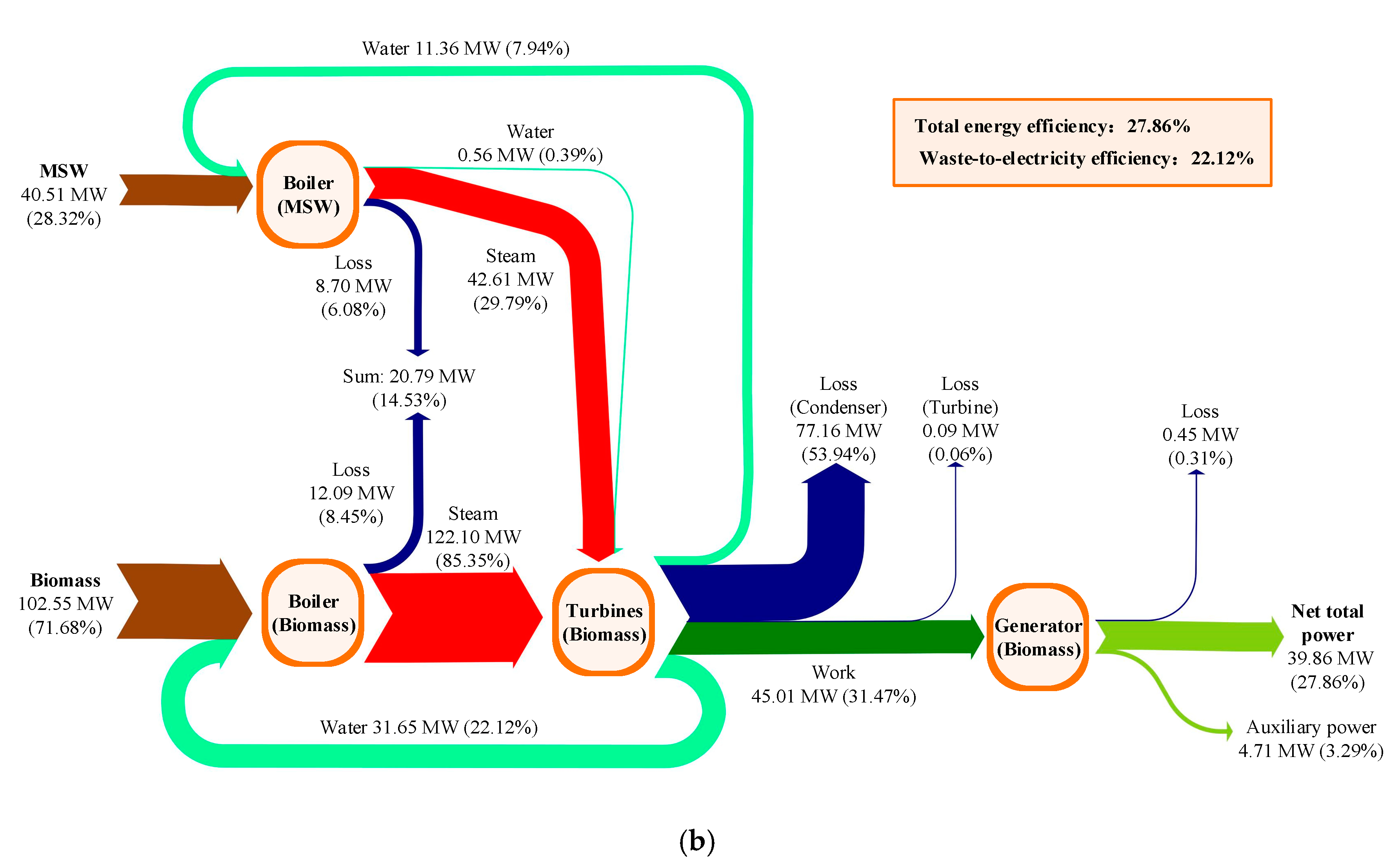
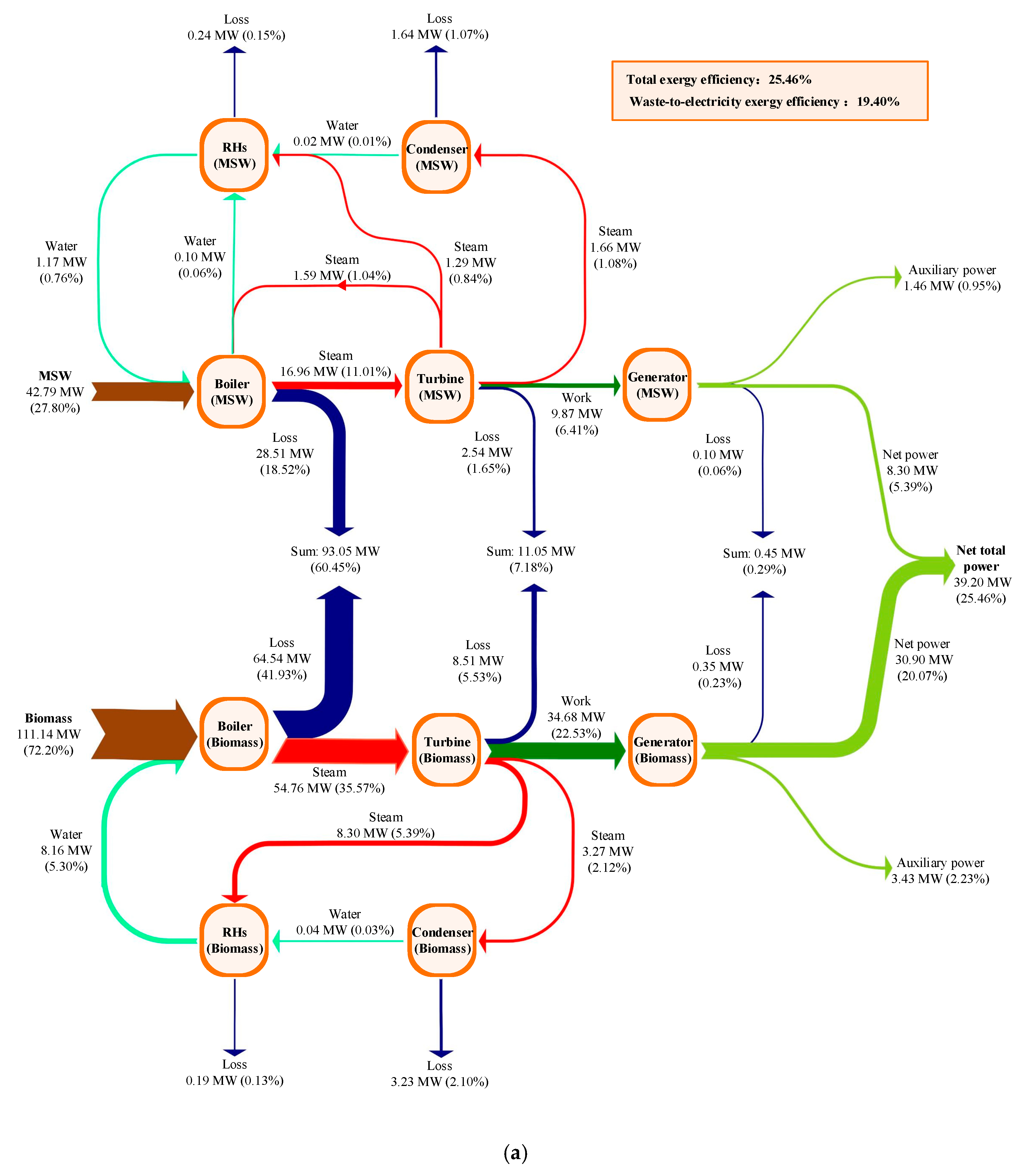
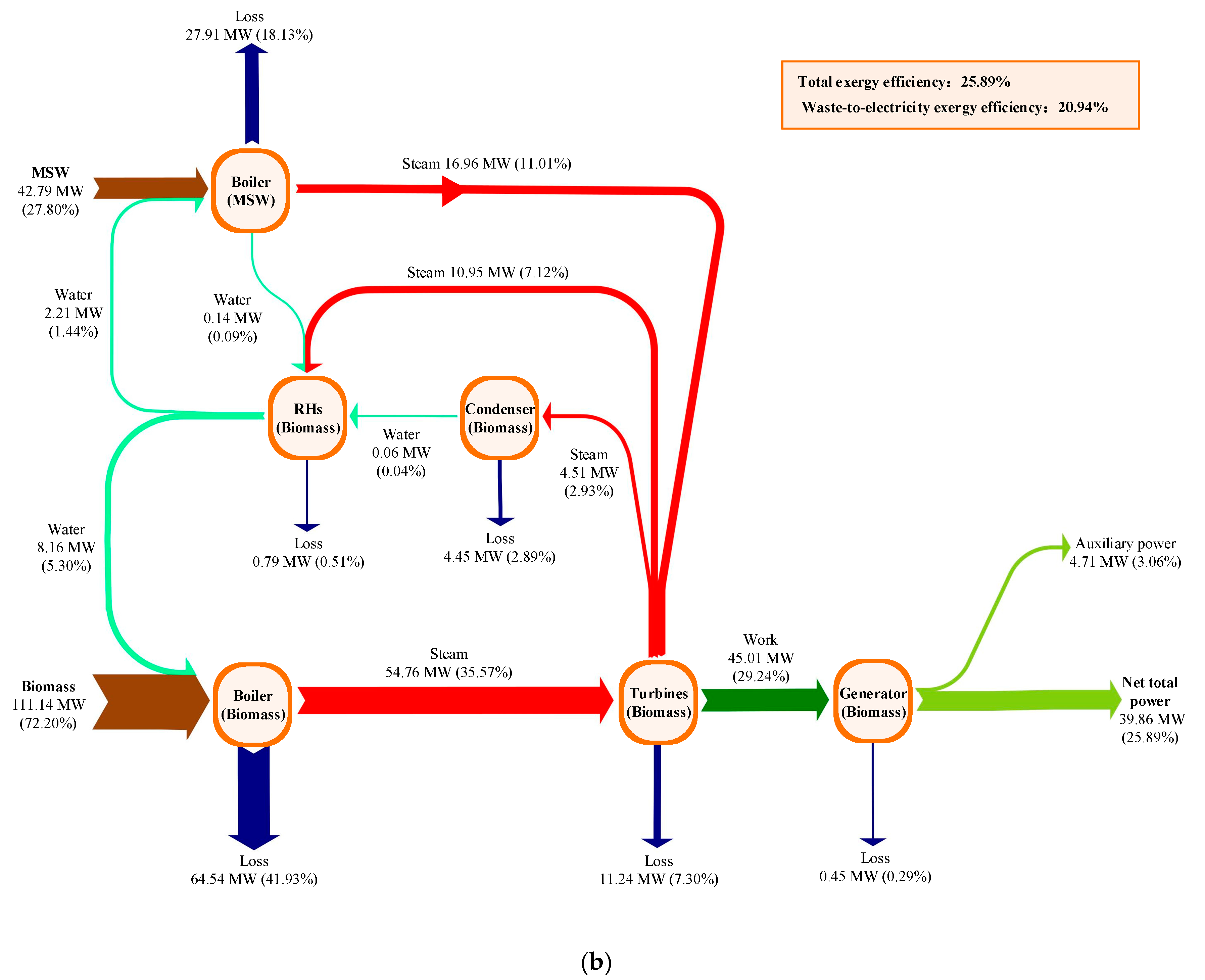
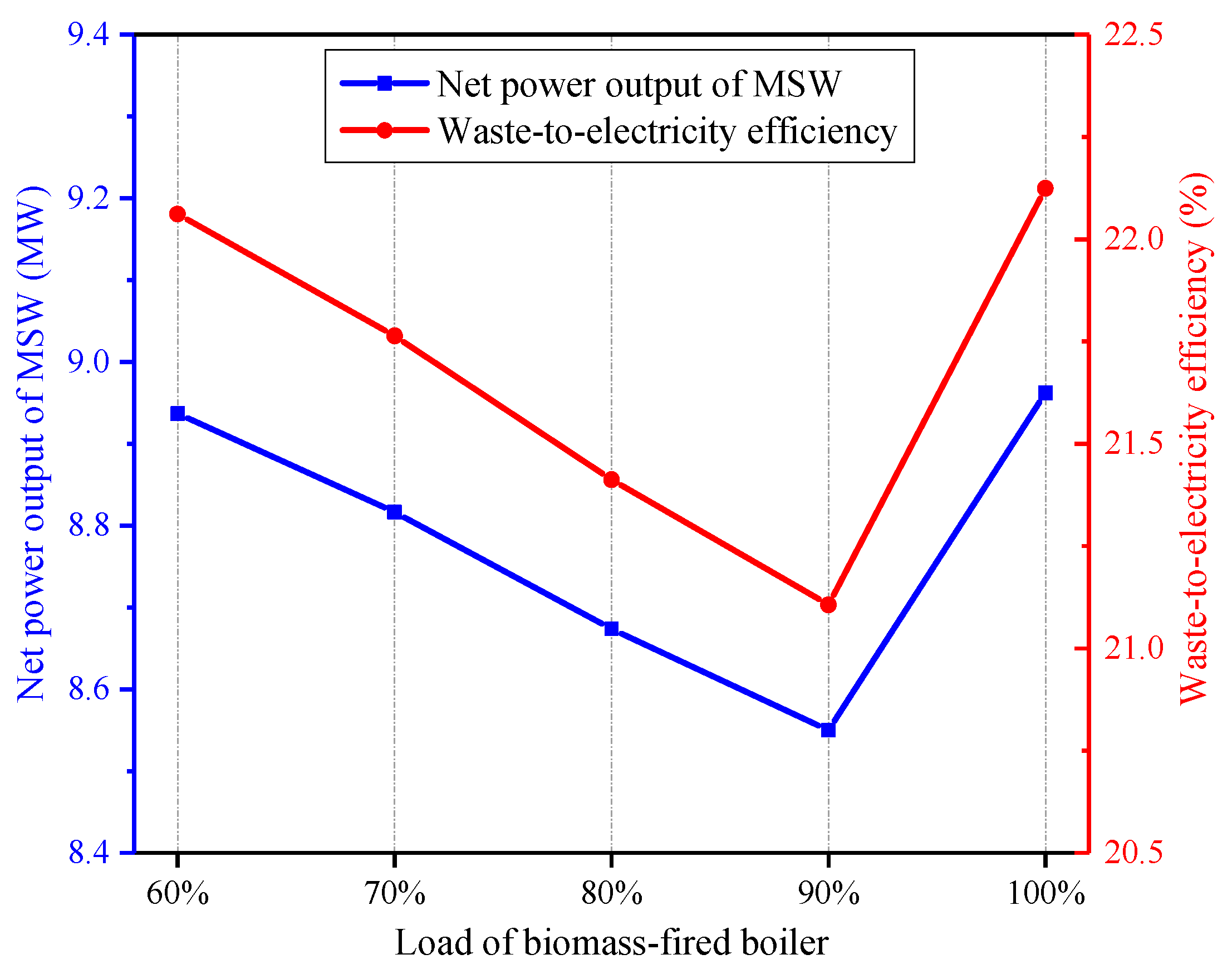
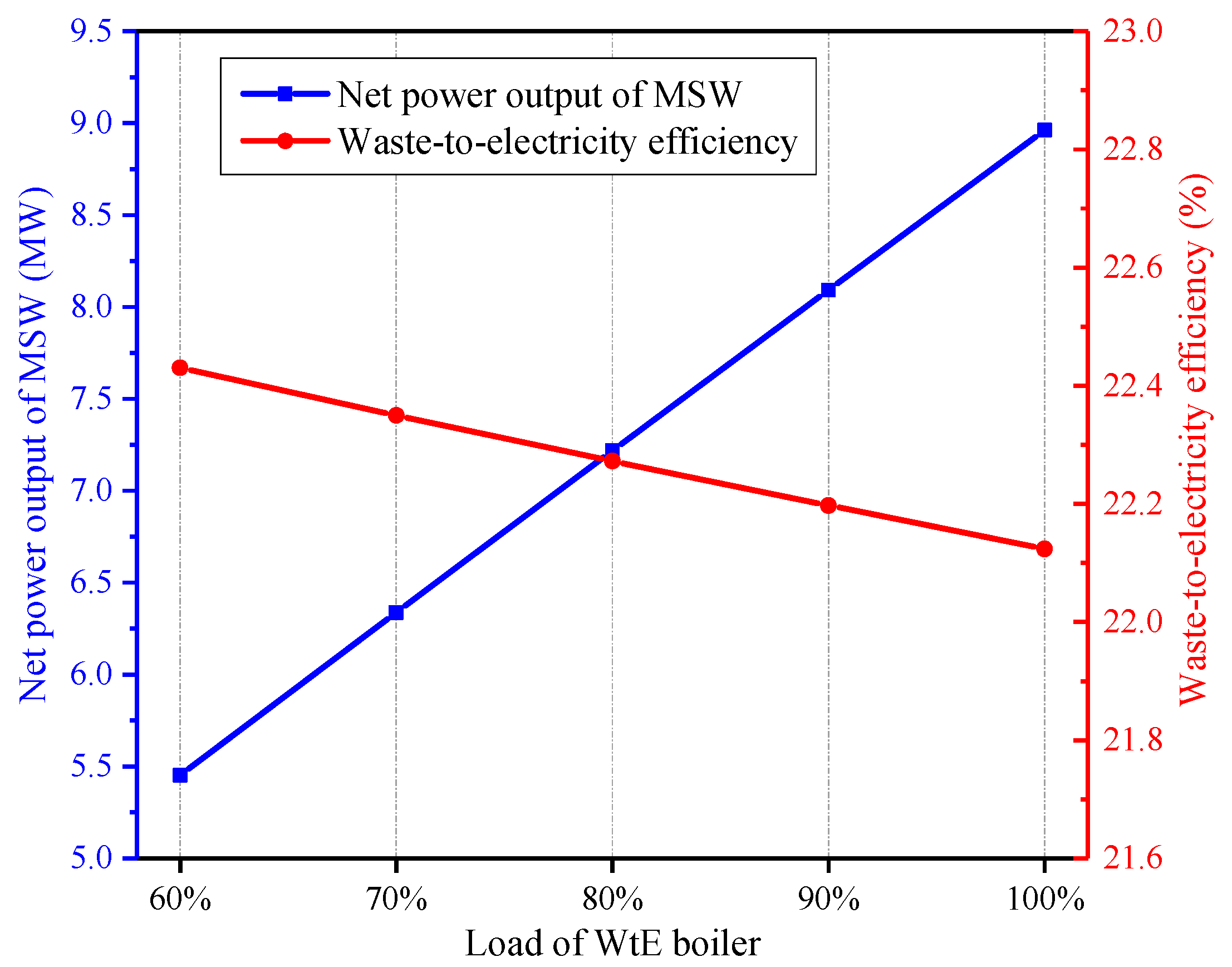
| Item | Unit | Value | |
|---|---|---|---|
| Feedstock (MSW) flow rate | t/h | 20.84 | |
| Lower heating value | MJ/kg | 7.00 | |
| Fuel energy input | MW | 40.51 | |
| Live steam (into turbine) | Flow rate | t/h | 48.60 |
| Pressure | MPa | 3.90 | |
| Temperature | °C | 395.0 | |
| Exhaust steam (into condenser) | Flow rate | t/h | 35.75 |
| Pressure | kPa | 6.80 | |
| Temperature | °C | 38.5 | |
| Exhaust gas temperature (out of boiler) | °C | 190.0 | |
| Boiler capacity (heat absorbed by working fluid) | MW | 37.47 | |
| Boiler efficiency | % | 78.53 | |
| Net power output | MW | 8.30 | |
| Waste-to-electricity efficiency | % | 20.49 | |
| Item | DEA (RH1) | RH2 | |
|---|---|---|---|
| Extraction steam | Flow rate (t/h) | 3.49 | 3.74 |
| Pressure (MPa) | 0.27 | 0.08 | |
| Temperature (°C) | 195.4 | 92.8 | |
| Drain water | Flow rate (t/h) | - | 3.74 |
| Temperature (°C) | - | 92.8 | |
| Feedwater | Outlet flow rate (t/h) | 51.1 | 39.74 |
| Outlet temperature (°C) | 130.0 | 88.0 | |
| Item | PAH | SAH | |||
|---|---|---|---|---|---|
| PAH1 | PAH2 | PAH3 | |||
| Hot fluid (steam/water) | Inlet pressure (MPa) | 4.54 | 1.31 | 4.54 | 1.31 |
| Inlet flow rate (t/h) | 2.23 | 3.89 | 2.23 | 1.76 | |
| Inlet/outlet temperature (°C) | 225.3/104.3 | 287.3/98.3 | 258.0/225.3 | 287.3/98.5 | |
| Cold fluid (air) | Inlet flow rate (t/h) | 73.84 | 73.84 | 73.84 | 30.17 |
| Inlet/outlet temperature (°C) | 15.0/31.0 | 31.0/166.0 | 166.0/220.0 | 15.0/166.0 | |
| Item | Unit | Value | |
|---|---|---|---|
| Feedstock (biomass) flow rate | t/h | 39.13 | |
| Lower heating value | MJ/kg | 9.435 | |
| Fuel energy input | MW | 102.55 | |
| Live steam (into turbine) | Flow rate | t/h | 128.99 |
| Pressure | MPa | 9.40 | |
| Temperature | °C | 535.0 | |
| Exhaust steam (into condenser) | Flow rate | t/h | 91.80 |
| Pressure | kPa | 4.90 | |
| Temperature | °C | 32.5 | |
| Exhaust gas temperature (out of boiler) | °C | 127.0 | |
| Boiler capacity (heat absorbed by working fluid) | MW | 91.36 | |
| Boiler efficiency | % | 89.10 | |
| Net power output | MW | 30.90 | |
| Biomass-to-electricity efficiency | % | 30.13 | |
| Item | RH1 | RH2 | DEA (RH3) | RH4 | RH5 | RH6 | |
|---|---|---|---|---|---|---|---|
| Extraction steam | Flow rate (t/h) | 7.88 | 5.83 | 3.64 | 5.04 | 5.80 | 9.00 |
| Pressure (MPa) | 2.55 | 1.32 | 0.59 | 0.40 | 0.19 | 0.07 | |
| Temperature (°C) | 381.4 | 353.5 | 278.2 | 190.5 | 126.8 | 88.2 | |
| Drain water | Flow rate (t/h) | 7.88 | 13.72 | - | 5.04 | 10.84 | 19.84 |
| Temperature (°C) | 192.4 | 158 | - | 118.4 | 88.2 | 32.5 | |
| Feedwater | Outlet flow rate (t/h) | 128.99 | 128.99 | 128.99 | 111.67 | 111.67 | 111.67 |
| Outlet temperature (°C) | 220.0 | 187.4 | 158.0 | 139.3 | 114.4 | 84.2 | |
| Item | Design | Calculated | Relative Error (%) | |
|---|---|---|---|---|
| Feedstock (MSW) flow rate (t/h) | 20.84 | 20.84 | 0.00 | |
| Live steam (into turbine) | Flow rate (t/h) | 48.60 | 48.60 | 0.00 |
| Pressure (MPa) | 3.90 | 3.90 | 0.00 | |
| Temperature (°C) | 395.0 | 395.0 | 0.00 | |
| Exhaust steam (into condenser) | Flow rate (t/h) | 35.68 | 35.75 | +0.20 |
| Pressure (MPa) | 6.80 | 6.80 | 0.00 | |
| Temperature (°C) | 38.5 | 38.5 | 0.00 | |
| Exhaust gas temperature (out of boiler) (°C) | 190.0 | 190.0 | 0.00 | |
| Net power output (MW) | 8.31 | 8.30 | −0.12 | |
| Waste-to-electricity efficiency (%) | 20.51 | 20.49 | −0.10 | |
| Item | Design | Calculated | Relative Error (%) | |
|---|---|---|---|---|
| Feedstock (biomass) flow rate (t/h) | 39.13 | 39.13 | 0.00 | |
| Live steam (into turbine) | Flow rate (t/h) | 128.99 | 128.99 | 0.00 |
| Pressure (MPa) | 9.40 | 9.40 | 0.00 | |
| Temperature (°C) | 535.0 | 535.0 | 0.00 | |
| Exhaust steam (into condenser) | Flow rate (t/h) | 91.69 | 91.80 | +0.12 |
| Pressure (MPa) | 4.90 | 4.90 | 0.00 | |
| Temperature (°C) | 32.5 | 32.5 | 0.00 | |
| Exhaust gas temperature (out of boiler) (°C) | 127.0 | 127.0 | 0.00 | |
| Net power output (MW) | 30.95 | 30.90 | −0.16 | |
| Biomass-to-electricity efficiency (%) | 30.18 | 30.13 | −0.17 | |
| Item | PAH | SAH | ||||
|---|---|---|---|---|---|---|
| PAH1 | PAH2 | PAH3 | SAH1 | SAH2 | ||
| Hot fluid (water/steam) | Inlet pressure (MPa) | 0.89 | 0.87 | 4.54 | 0.89 | 0.87 |
| Inlet flow rate (t/h) | 18.04 | 36.29 | 2.23 | 7.38 | 14.83 | |
| Inlet/outlet temperature (°C) | 93.2/35.0 | 174.0/130.1 | 258.0/225.3 | 93.2/35.0 | 174.0/130.1 | |
| Cold fluid (air) | Inlet flow rate (t/h) | 73.84 | 73.84 | 73.84 | 30.17 | 30.17 |
| Inlet/outlet temperature (°C) | 15.0/74.1 | 74.1/166.0 | 166.0/220.0 | 15.0/74.1 | 74.1/166.0 | |
| Item | Unit | Separate Scheme | Integrated Scheme | Difference |
|---|---|---|---|---|
| Feedstock (biomass) flow rate | t/h | 39.13 | 39.13 | 0.00 |
| Feedstock (MSW) flow rate | t/h | 20.84 | 20.84 | 0.00 |
| Gross total power output | MW | 44.10 | 44.57 | +0.47 |
| Total auxiliary power | MW | 4.90 | 4.71 | −0.19 |
| Net total power output | MW | 39.20 | 39.86 | +0.66 |
| Net power output of biomass | MW | 30.90 | 30.90 | 0.00 |
| Net power output of MSW | MW | 8.30 | 8.96 | +0.66 |
| Total energy efficiency | % | 27.40 | 27.86 | +0.46 |
| Waste-to-electricity efficiency | % | 20.49 | 22.12 | +1.63 |
| Item | Ref [26] | Ref [28] | Current paper |
|---|---|---|---|
| Integrated scheme | WtE + gas turbine combined cycle | WtE + coal-fired power plant | WtE + biomass-fired power plant |
| Fuels | MSW + natural gas | MSW + coal | MSW + biomass |
| Waste-to-electricity efficiency of conventional WtE system (%) | 26.9 | 20.49 | 20.49 |
| Waste-to-electricity efficiency of integrated WtE system (%) | 33.8 | 29.65 | 22.12 |
| Improvement in waste-to-electricity efficiency due to integration (%) | 6.9 | 9.16 | 1.63 |
| Item | Unit | Value | |
|---|---|---|---|
| Capital cost of reference WtE plant [33] | million USD | 28.25 | |
| Operational cost of reference WtE plant [33] | million USD | 2.83 | |
| Lifetime of WtE plant [34] | Construction | year | 2 |
| Economic | year | 23 | |
| Annual operating time of WtE plant [34] | h | 7200 | |
| Loan ratio [33] | - | 70% | |
| Loan term [33] | year | 15 | |
| Interest rate [33] | - | 6.15% | |
| Discount rate [33] | - | 12% | |
| Disposal fee [33] | USD/t | 9.65 | |
| Feed-in tariff [35] | USD/(kW·h) | 0.97 | |
| Income tax rate in economic duration [34] | 1st–3rd year | - | 0% |
| 4th–6th year | - | 12.5% | |
| 7th–23rd year | - | 25.0% | |
| Scaling Up Method | |||||
|---|---|---|---|---|---|
| Component | Basic Cost (Million USD) | Basic Scale | Scale Unit | Scale Factor | Reference |
| PAH, SAH | 0.78 | 8372 | m2 | 1 | [36,37] |
| Stack | 10.65 | 4039.2 | t/h | 1 | [36,38] |
| Condenser | 4.28 | 36000 | m2 | 1 | |
| Cooling tower | 17.01 | 13000 | m2 | 1 | |
| Function method | |||||
| Turbine | [39] | ||||
| Pump | |||||
| Generator | [40] | ||||
| DEA | [28] | ||||
| RH | [41] | ||||
| PRV | [42] | ||||
| Component | Separate Scheme (Thousand USD) | Integrated Scheme (Thousand USD) | Difference | |
|---|---|---|---|---|
| WtE section | Turbine | 4111.07 | - | −4111.07 |
| Generator | 370.30 | - | −370.30 | |
| Condenser | 118.78 | - | −118.78 | |
| Circulating water pump | 146.65 | - | −146.65 | |
| Cooling tower | 1504.68 | - | −1504.68 | |
| CP | 9.02 | - | −9.02 | |
| RH | 19.08 | - | −19.08 | |
| DEA | 32.30 | - | −32.30 | |
| Stack | 337.81 | - | −337.81 | |
| PAH | 178.94 | 297.13 | +118.19 | |
| SAH | 42.14 | 119.01 | +76.87 | |
| Biomass power section | Turbine | 10036.51 | 13904.86 | +3868.34 |
| Generator | 1221.93 | 1565.63 | +343.70 | |
| PRV | - | 0.11 | +0.11 | |
| AP | - | 0.72 | +0.72 | |
| Sum | 18129.20 | 15887.46 | −2241.74 | |
| Item | Separate Scheme | Integrated Scheme | Difference |
|---|---|---|---|
| Total capital cost (million USD) | 28.25 | 26.01 | −2.24 |
| Operational cost (million USD) | 2.83 | 2.60 | −0.23 |
| Annual amount of MSW disposal (103 t) | 150 | 150 | 0.00 |
| Annual electricity supply (GW·h) | 59.76 | 64.52 | +4.76 |
| Annual revenue due to MSW disposal (million USD) | 1.45 | 1.45 | 0.00 |
| Annual revenue due to electricity sale (million USD) | 5.77 | 6.23 | +0.46 |
| Total annual revenue (million USD) | 7.22 | 7.68 | +0.46 |
| Net present value (million USD) | 5.26 | 10.28 | +5.02 |
| Dynamic payback period (year) | 8.18 | 5.37 | −2.81 |
© 2020 by the authors. Licensee MDPI, Basel, Switzerland. This article is an open access article distributed under the terms and conditions of the Creative Commons Attribution (CC BY) license (http://creativecommons.org/licenses/by/4.0/).
Share and Cite
Pan, P.; Zhang, M.; Xu, G.; Chen, H.; Song, X.; Liu, T. Thermodynamic and Economic Analyses of a New Waste-to-Energy System Incorporated with a Biomass-Fired Power Plant. Energies 2020, 13, 4345. https://doi.org/10.3390/en13174345
Pan P, Zhang M, Xu G, Chen H, Song X, Liu T. Thermodynamic and Economic Analyses of a New Waste-to-Energy System Incorporated with a Biomass-Fired Power Plant. Energies. 2020; 13(17):4345. https://doi.org/10.3390/en13174345
Chicago/Turabian StylePan, Peiyuan, Meiyan Zhang, Gang Xu, Heng Chen, Xiaona Song, and Tong Liu. 2020. "Thermodynamic and Economic Analyses of a New Waste-to-Energy System Incorporated with a Biomass-Fired Power Plant" Energies 13, no. 17: 4345. https://doi.org/10.3390/en13174345
APA StylePan, P., Zhang, M., Xu, G., Chen, H., Song, X., & Liu, T. (2020). Thermodynamic and Economic Analyses of a New Waste-to-Energy System Incorporated with a Biomass-Fired Power Plant. Energies, 13(17), 4345. https://doi.org/10.3390/en13174345





